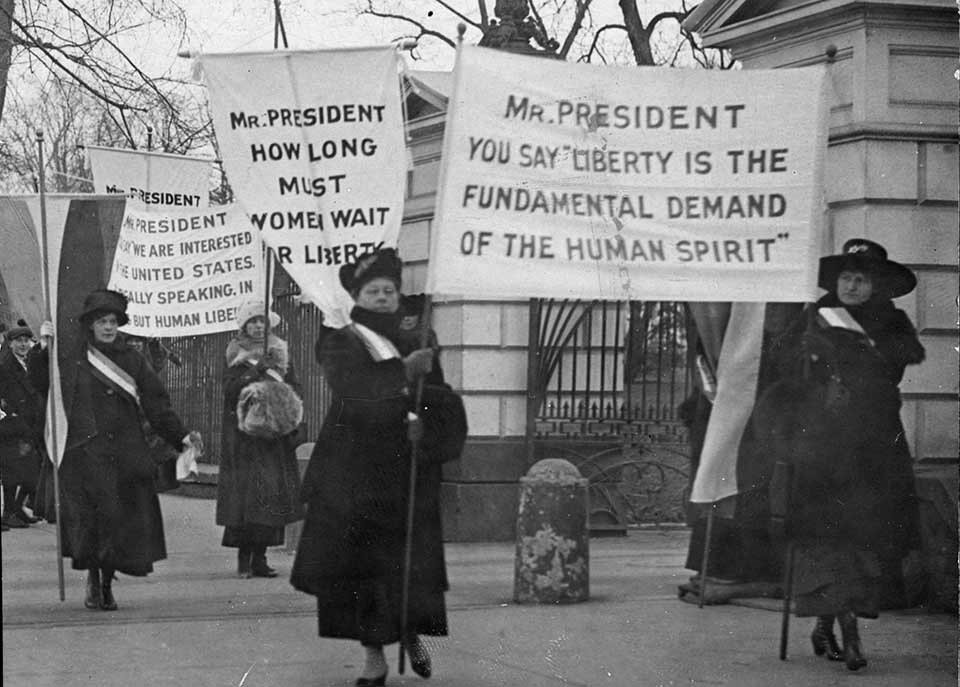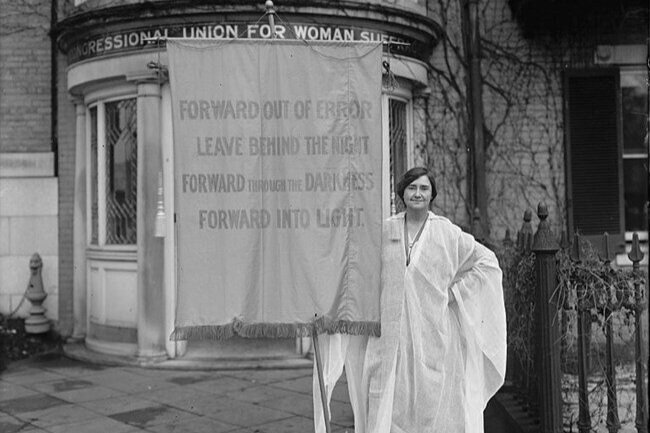What We're Reading: Women's Suffrage
What We’re Reading: U.S. Women’s Suffrage
August is National Women’s Suffrage Month and the Trust for the National Mall is joining national and local organizations and institutions in celebrating the centennial of the 19th Amendment.
The women’s suffrage movement historically began in 1848 at what is now the Women’s National Historical Park in Seneca Falls, NY, and progressed in supporters through the states and the capitol. The National Mall, a civic platform for First Amendment rights became a stage in 1913 for the Women’s Suffrage Parade.
We have gathered some resources of artifacts, exhibits, and historic research we are ourselves reading to learn more about the women and men and events that led to the ratification of the amendment on August 18, 1920, which gave women the constitutional right to vote.
THE 2020 WOMEN'S VOTE CENTENNIAL INITIATIVE
The year 2020 marks the 100th anniversary of the passage of the 19th Amendment, guaranteeing and protecting women's constitutional right to vote. This historic centennial offers an unparalleled opportunity to commemorate a milestone of democracy and to explore its relevance to the issues of equal rights today. The Women's Vote Centennial Initiative, a collaboration of women-centered institutions, organizations, and scholars from across the US, works to ensure that this anniversary, and the 72-year fight to achieve it, are commemorated and celebrated throughout the United States.
SUFFRAGE IN 60 SECONDS
For the 100th anniversary of the ratification of the 19th Amendment to the Constitution enfranchising women, National Park Service park rangers at the Belmont-Paul Women's Equality National Monument created these one-minute videos that highlight suffrage subjects and the heroes who made woman suffrage a reality—including those women who continued the fight for full enfranchisement beyond 1920.
Rightfully Hers: American Women and the Vote
National Archives Museum
This landmark voting rights victory was made possible by decades of suffragists’ persistent political engagement, and yet it is just one critical milestone in women’s battle for the vote. In celebration of the 100th anniversary of the 19th Amendment, Rightfully Hers: American Women and the Vote highlights the relentless struggle of diverse activists throughout U.S. history to secure voting rights for all American women.
Creativity and Persistence: Art that Fueled the Fight for Women’s Suffrage
National Endowment for the Arts
The Arts Endowment made grants to organizations producing arts projects related to the fight for women’s suffrage as part of this year’s celebration.
In August 2020, the National Endowment for the Arts published Creativity and Persistence: Art that Fueled the Fight for Women’s Suffrage. The book commemorates how the arts were used to change the image of women in America and illustrate the importance of their full participation in society and politics.
The National Endowment is also featuring in its issue of the magazine, American Artscape, project submission funding requests that celebrate women’s suffrage and equality. They range from a festival that highlights the creativity of women filmmakers to a play for young audiences that outlines the history of the suffrage movement.
Suffrage at 100: A Visual History
The New York Times
The NYTimes presents a visual timeline of the people and events that led to the enfranchisement of women in 1920. It represents the suffragists “in every corner of the country.”
And Nothing Less Podcast
National Park Service
Written by suffragists Susan B. Anthony and Elizabeth Cady Stanton, women’s rights activists used this rallying cry to demand voting equality. But the suffrage movement included far more voices and perspectives than these two well-known names: throughout the fight for women’s right to vote, generations of diverse activists demanded full access to the ballot box. Hosts Rosario Dawson and Retta guide us through this seven-part series from the Women’s Suffrage Centennial Commission and PRX, bringing us the stories we didn’t learn in our history books.
And Nothing Less is the official podcast commemorating 100 years of the 19th Amendment and women's constitutional right to vote.
Our Story: Portraits of Change
Our Story: Portraits of Change is an interactive photo mosaic and art installation depicting a portrait of suffragist and civil rights activist Ida B. Wells. Created by artist Helen Marshall of the People’s Picture, commissioned by the Women’s Suffrage Centennial Commission, and produced by Christina Korp, Purpose Entertainment, Our Story commemorates the 100th anniversary of the 19th Amendment and women’s right to vote in the United States. From August 24-28, a 25 ft by 40 ft (1,000 square feet) installation of the photo mosaic will be on display at Union Station in Washington, DC.
The final portrait is made up of thousands of photos telling myriad stories of the suffrage movement. In the online mosaic, you can zoom in, click on the 100 portraits and stories, and find out more about the many programs and events happening nationwide to commemorate the suffrage centennial in 2020.
Poetry towards Progress: Frances E. W. Harper
Smithsonian Libraries
An activist, a teacher, a poet — Frances Ellen Watkins Harper was an extraordinary figure in American history.
Her activism continued well past abolition. Harper was a life-long champion of rights for both African Americans and women. While suffrage was an important issue for Harper, she and other black suffragists were often excluded from the conversation by their white counterparts. In 1894, she helped form the National Association of Colored Women alongside Mary Church Terrell, an organization that addressed the needs of both women and black Americans.
WHAT 100 YEARS OF WOMEN’S SUFFRAGE LOOKS LIKE THROUGH THE EYES OF 100 WOMEN ARTISTS
Smithsonian Magazine
Award-winning author and art historian Bridget Quinn’s latest: She Votes: How U.S. Women Won Suffrage, and What Happened Next recounts the diverse array of women who fought for equality throughout American history, both in the decades leading up to the amendment’s ratification and in the generations since.
To help tell this complex story, Quinn brought on 100 women artists, each illustrating a historical figure, or scene, in their respective styles.
The Magic Sash Podcast
National Park Service
The Magic Sash is a journey back in time hosted by gold medal gymnast and advocate Aly Raisman. Join Lotty and Isaiah, two very modern fifth graders, as they meet iconic heroes of the movement for women’s right to vote and experience big moments in women’s suffrage first-hand. They’ll learn that what women (and men) fought for — women’s full political equality — isn’t dusty history at all.
African American Women and the Nineteenth Amendment
By Sharon Harley, National Park Service
African American women, though often overlooked in the history of woman suffrage, engaged in significant reform efforts and political activism leading to and following the ratification in 1920 of the Nineteenth Amendment, which barred states from denying American women the right to vote on the basis of their sex.
For Black women, the 19th Amendment didn’t end their fight to vote
National Geographic
Martha S. Jones, a noted historian, examines two myths about what the 19th Amendment did—and didn’t—do for women in 1920.
Spotlight: Woman's Suffrage
National Portrait Gallery
View collection highlights form the Smithsonian’s National Portrait Gallery highlighting Women’s Suffrage.
Sojourner Truth:
The Woman, The Myth, The Legend
National Women’s History Museum
As an itinerant preacher, abolitionist, and women's rights activist, Sojourner Truth spoke out against the injustices affecting various communities. Propelled by her faith, Truth traveled extensively to speak about her experiences as both a woman and a former slave. Although the most popular quotes attributed to her legacy are inaccurate, Truth's activism led her to become one of the most recognizable figures in American History.
Women of PROTEST
Library of Congress
Photographs from the Records of the National Woman's Party and Historical Timeline of the National Womans Party.
19th Amendment By State
National Park Service
Learn more about the US states and territories and their role in ratifying the 19th Amendment. Did your state vote to ratify the amendment? Find out!
An Overview of the 19th Amendment
Belmont-Paul Women's Equality National Monument, Women's Rights National Historical Park, National Park Service
In 1848 women and men met in Seneca Falls, New York to advance the cause for women’s rights. The convention, organized by Elizabeth Cady Stanton, Lucretia Mott, Martha Wright, Mary Ann M'Clintock, and Jane Hunt marked the beginning of a formal women’s suffrage movement. The men and women of the movement made speeches and petitioned Congress, pressuring government officials to recognize the woman’s right to vote. Stanton, Mott, and suffrage advocate Susan B. Anthony did not live to see women get the right to vote. Instead, they paved the way for future suffragists like Alice Paul, Ida B. Wells, and Mabel Ping-Hua Lee.
1913 Woman Suffrage Procession
Belmont-Paul Women's Equality National Monument, National Mall and Memorial Parks
On March 3, 1913, the day before Woodrow Wilson's presidential inauguration, thousands of women marched along Pennsylvania Avenue--the same route that the inaugural parade would take the next day--in a procession organized by the National American Woman Suffrage Association (NAWSA).
Alice Paul Institute
The Alice Paul Institute is proud to honor the 100th anniversary of the passage of the 19th Amendment with this digital exhibit.
The items featured here were chosen because of the story that they tell. Together, they spotlight an often forgotten or marginalized history of how American women actually fought, and even went to jail, for their right to vote. It reveals the tactics used in a long-term, non-violent campaign of political strategy with calculations of public messaging. The women’s suffrage movement in the United States was a cause conceived and led by women who had no legal standing but who were determined to be full citizens of a nation that modeled true democracy.
2020: Through the Lens of Researchers – Online Exhibition
Alice Paul Institute
The Alice Paul Institute is proud to honor the 100th anniversary of the passage of the 19th Amendment with a digital exhibit supported by researchers in the field. Though there are currently limitations with sharing history in person, it is important to the Alice Paul Institute that the history of the 19th Amendment is shared. This exhibit will be updated throughout the year with the support of researchers. Continue to check back to see what more you can learn about the suffrage movement in the United States.
Votes for women:
A Suffrage Symbol
National Museum of American History
Three generations of women fought to overcome objections and convince the male voters who would decide the issue that women had the right to vote. Opponents claimed that woman suffrage would lead to neglected children, masculine women, confused gender roles, and prohibition. Suffragists and supporters countered with images of strong but feminine voters with years of experience and contributions as mothers, homemakers, breadwinners, and community activists.





















